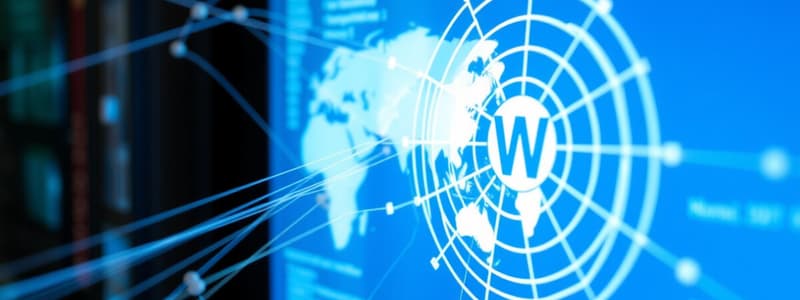Podcast
Questions and Answers
IOS is the operating system developed by ______
IOS is the operating system developed by ______
Apple
Online functions include email and ______ from server.
Online functions include email and ______ from server.
notification
A common type of malware that can delete files is called a ______.
A common type of malware that can delete files is called a ______.
virus
Phishing is a method used for ______ theft.
Phishing is a method used for ______ theft.
One of the netiquette rules is to treat others how you want to be ______.
One of the netiquette rules is to treat others how you want to be ______.
The ______ is an information system that connects documents.
The ______ is an information system that connects documents.
Web 2.0 allows users to ______ with the pages.
Web 2.0 allows users to ______ with the pages.
Folksonomy allows users to categorize information using freely chosen ______.
Folksonomy allows users to categorize information using freely chosen ______.
Web 3.0 is also known as the ______ Web.
Web 3.0 is also known as the ______ Web.
A major problem of Web 3.0 is ______ due to imprecise words.
A major problem of Web 3.0 is ______ due to imprecise words.
______ allows users to share media like images, music, and videos.
______ allows users to share media like images, music, and videos.
Assistive media is designed to help people with visual and reading ______.
Assistive media is designed to help people with visual and reading ______.
Social ______ allows you to connect with other people online.
Social ______ allows you to connect with other people online.
Flashcards are hidden until you start studying
Study Notes
ICT Fundamentals
- Information: Facts acquired about a subject or individual.
- Communication: The process of sharing information or news.
- Technology: Machinery and equipment developed through knowledge.
- ICT: Involves various communication technologies for data exchange.
- State of the ICT: Reflects the current landscape of ICT globally.
The World Wide Web (WWW)
- An information system linking documents via hypertext.
- URL (Uniform Resource Locator): The address for accessing resources on the internet.
- Interlinked by hypertext links, allowing direct connections to other documents.
Evolution of the Web
-
Web 1.0:
- Emerged in the early 1990s, created by Tim Berners-Lee.
- Characterized by static, unchangeable pages.
-
Web 2.0:
- Introduced in 1999, featuring dynamic pages.
- Users interact with pages differently; allows comments and account creation.
- Encourages user-generated content and social interaction.
Key Features of Web 2.0
- Folksonomy: Users categorize information with freely chosen keywords (tagging).
- Rich Use Experience: Interactive and responsive design based on user input.
- Longtail Services: On-demand services rather than one-time purchases.
- Software as a Service (SaaS): Subscription-based access to applications.
- Mass Participation: Universal access enables diverse content sharing.
Web 3.0
- Known as the Semantic Web, promoted by W3C (World Wide Web Consortium).
- Emphasizes data sharing and revision across various applications and communities.
Challenges of Web 3.0
- Compatibility Issues: HTML files may lack support.
- Security Risks: Personal data vulnerabilities through saved user references.
- Vastness: Billions of web pages complicate navigation.
- Vagueness: Imprecise language and terms can hinder clarity.
Trends in ICT
- Convergence: The integration of technologies to achieve unified goals.
- Social Media: Online platforms for interaction and information sharing.
- Social Networks: Facilitate connections among users.
- Bookmarking Websites: Tools for storing and managing web links.
- Media Sharing: Platforms for uploading and distributing media content.
- Microblogging: Short content updates focused on user engagement.
- Blogs and Forums: Spaces for expressing opinions and exchanging knowledge.
- Assistive Media: Services for individuals with visual or reading impairments.
Operating Systems
- iOS (Apple), Android (Google), Blackberry OS, Windows Phone, Symbian, WebOS (LG), Windows Mobile.
Online Systems and Functions
- Online Systems: Require internet connectivity for access.
- Online Functions: Email, server notifications, live updates, etc.
Online Platforms
- Online marketplaces, social media, search engines, communication services, payment systems, advertising platforms, and creative content outlets.
Internet Safety Guidelines
- Emphasize safety, privacy, and reliability.
- Risks associated with sharing certain personal information, including:
- Full names and school history
- Contact numbers and addresses
- Birth dates
Internet Threats
- Malware: Malicious software types include:
- Virus: Attaches to files; needs user action to replicate.
- Worms: Self-replicating; slows down systems without deleting files.
- Trojan Horse: Malicious software posing as legitimate applications.
- Spyware: Collects data about users for malicious purposes.
- Adware: Unwanted advertisements displayed on user screens.
- Spam: Unwanted emails flooding user inboxes.
- Phishing: Identity theft tactic via fraudulent communication.
- Pharming: Redirecting users to fake websites.
Netiquette (Network Etiquette)
- Adhere to the golden rule of treating others as you wish to be treated.
- Avoid flaming (internet insults), typing in all caps, and spamming.
- Interact cautiously with strangers online, respect copyright, and use proper grammar.
- Ensure safe shopping on sites with robust security measures like TLS or SSL.
Studying That Suits You
Use AI to generate personalized quizzes and flashcards to suit your learning preferences.




